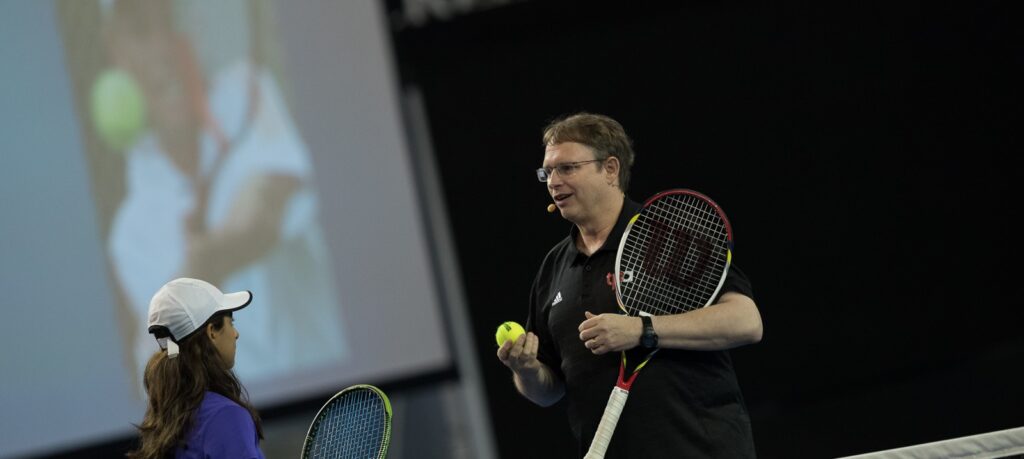

‘ATHLETE’
In this article, we will explore the ‘Athlete’ component of our player vision statement:
“A Performer who is an Athlete that Plays Smart with Functional Shots.”
Most of our work at NVTC is with U12 junior players, so everything in this article will be done from that perspective.
If you work with older athletes, you may choose to make your Athlete Mission more suitable for their age and stage of development.
Our Mission Statement for developing an athlete is:
PLAYGROUND
“Develop fundamental movement skills (FMS), coordination & perceptual motor skills in a gamified and competitive environment.”
KEY PRINCIPLE: Develop an athlete first
It is better to build an athlete first and a tennis player second for long-term performance player development. For example, keeping kids in other sports as long as possible is advantageous. Specializing in tennis early doesn’t mean they will be better players later on. Players who specialize early risk not having the athletic skills to win at higher levels when athletic adaptation is required. Also, a developed athlete is far more resistant to injuries and can recover faster if they do occur.
Let’s jump into looking at the components of the mission statement:
‘GAMIFIED’ & COMPETITIVE ENVIRONMENT
Physical training can be hard work. Young players may lack the appropriate motivation to see the benefits and dislike the experience. The solution is to saturate the environment with activities constructed as much for an enjoyable experience as physical training.
FUNDAMENTAL MOVEMENT SKILLS
Just like literacy (ability to read and write) is the foundation for academic learning, physical literacy is the foundation for athletics. Physical literacy for sport requires developing Fundamental Movement Skills (FMS). These include:
- Locomotion Skills: Jumping, hopping, running, bounding, as well as tennis-specific shuffling, crossovers, and back-pedalling.
- Manipulation Skills: Throwing, catching and tennis-specific reception & projection racquet skills.
- Balance & Stability: Maintaining and re-gaining static as well as dynamic balance.
COORDINATION
Of all the physical capacities, coordination is identified by motor learning experts as the primary one that determines success in tennis (The German Tennis Federation has a good body of work on this). Not to say that a player’s size, strength, etc. are not considerations, just that coordination should be a priority for tennis athletic development. All too often, the majority of physical training for tennis is about making the strongest and fastest players (who are not automatically the most successful in tennis). Neglecting coordination is missing the main point.
PERCEPTUAL MOTOR SKILLS
In motor learning, tennis is classified as an ‘Open skill’ using ‘Perceptual Motor Skills.’ (For an article on Open Skills, click here) Game sports like tennis use skills that must adapt to the situation. This is in contrast to sports like gymnastics or diving, which use ‘Closed’ skills. The critical goal of coordination development for tennis is to make a player who is technically highly adaptable.
Effective & Efficient:
Two additional benefits of this kind of training are it leads to technique that is ‘effective’ (Being able to make the ball do what you want) and ‘efficient (No wasting of energy, the ability to cover the court smoothly and to create, ‘power without effort’). Effective and efficient players are not ‘victims of the ball.’ They play the ball and make it their slave instead of allowing the ball to play them. They can hit just as hard in the final set tie-breaker as in the first game of the match. Playing efficiently also means less stress on the body, translating to less potential for injury.
CONCLUSION
Keeping with the principle, ‘Build an athlete first, a player second,’ we must keep in mind that we are not just building any athlete but a tennis athlete. To lay the groundwork for a long-term foundation for U12 players, we must prioritize the #1 capacity for tennis, which is coordination. Coordination will allow them to handle the demands of the open skill/perceptual-motor skill of tennis. They will gain a solid base for highly adaptable technique that is efficient & effective, allowing them not to waste energy and minimize injury.
Leave a Reply